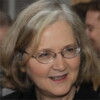Elizabeth Blackburn

Elizabeth Blackburn
Elizabeth Helen Blackburn, AC, FRS, FAA, FRSNis an Australian-American Nobel laureate who is currently the President of the Salk Institute for Biological Studies. Previously she was a biological researcher at the University of California, San Francisco, who studied the telomere, a structure at the end of chromosomes that protects the chromosome. Blackburn co-discovered telomerase, the enzyme that replenishes the telomere. For this work, she was awarded the 2009 Nobel Prize in Physiology or Medicine, sharing it with Carol W. Greider...
NationalityAustralian
ProfessionScientist
Date of Birth26 November 1948
CityHobart, Australia
CountryAustralia
Perhaps arising from a fascination with animals, biology seemed the most interesting of sciences to me as a child.
If a test showed you had telomere shortening, it would be a red flag suggesting you should take a look at possible risk factors.
I've only actively promoted what we always hope is good science.
Biology sometimes reveals its fundamental principles through what may seem at first to be arcane and bizarre.
What is it that keeps you so interested in the telomere? It's so intricate and complicated, and you want to know how it works.
In 2004, results from a study that I worked on with colleagues at the University of California, San Francisco, linked chronic stress to shortening of telomeres.
This enzyme, called telomerase, slows the rate at which telomeres degrade, and research indicates that healthy people with longer telomeres have less risk of developing the common illnesses of aging - like heart disease, diabetes, and cancer, which are three big killers today.
The most dangerous cancer cells are actually the ones that are more like stem cells, which have this ability to produce themselves over and over again. More and more cancer biologists say stem-cell-like cells in cancers are the most dangerous.
Studying organisms at a molecular level was totally compelling because it was moving from being a naturalist, which was the 19th-century kind of science, to being very focused and really getting to the heart of these molecules.
One characteristic aspect of ageing is the increased susceptibility to disease, particularly age-related diseases such as cardiovascular diseases and cancer.
I was born in the small city of Hobart in Tasmania, Australia, in 1948. My parents were family physicians. My grandfather and great grandfather on my mother's side were geologists.
Researchers have found that the brain definitely sends nerves directly to organs of the immune system and not just to the heart and the lower gut. In that way, too, the brain is influencing the body.
In the 1970s, I did a Ph.D. with Fred Sanger in Cambridge who was in the process of inventing ways to map what's inside DNA. He later won the Nobel Prize.
I decided I wanted to go to Cambridge, and then I got introduced to Fred Sanger. I was very conscientious, and I asked him when I first got there if I should start reading up on things. But he said, 'No, I think you can just start these experiments,' so I plunged right in.